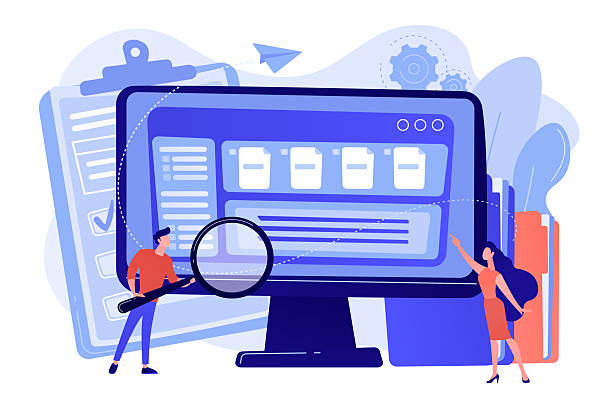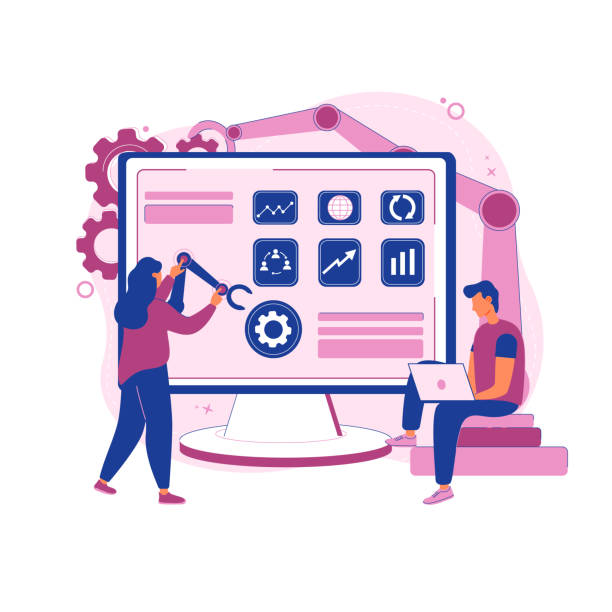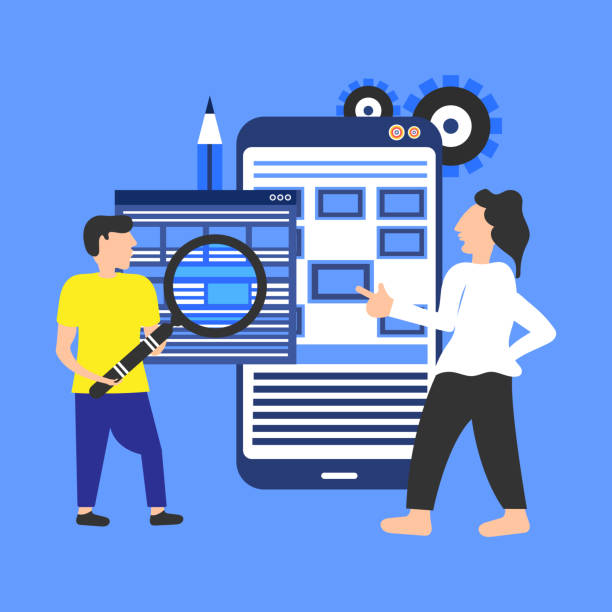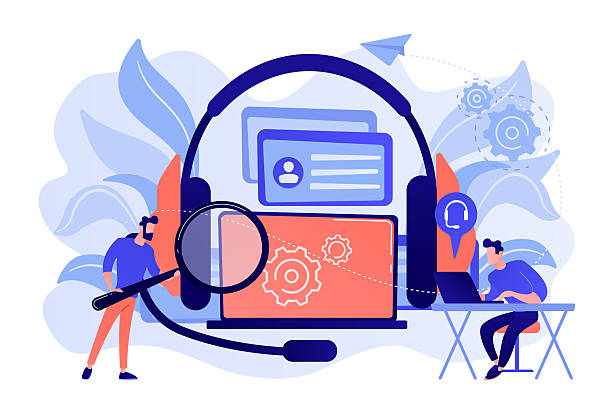Why Website Speed is a Necessity, Not an Option?

In today’s world where speed is paramount, #FastWebsiteDesign is no longer a competitive advantage, but an undeniable necessity.
Internet users have little patience, and research shows that if a website does not load in less than three seconds, a significant portion of visitors will leave.
This early departure, known as #BounceRate or #Bounce_Rate, not only leads to the loss of potential customers but also negatively impacts your site’s ranking in search engines.
Leading search engines like Google consider page loading speed as one of the key factors in their ranking algorithms.
Therefore, a slow-loading website effectively keeps itself out of sight of customers and reduces its chances of success.
#PositiveUserExperience is tied to high speed, and in the information age, any business seeking sustainability and growth must prioritize fast website design in its plans.
This is not just a technical issue; it directly affects website SEO and, consequently, your incoming traffic.
Failure to pay attention to this issue can lead to missing countless opportunities in today’s competitive market.
This section of our content provides an analytical look at the fundamental importance of speed in online success.
Dissatisfied with low sales from your online store?
RasaWeb is your solution for a professional and high-selling online store.
✅ Significant increase in sales and revenue
✅ Easy and enjoyable shopping experience for customers
⚡ Get a free consultation from RasaWeb now!
Key Factors Affecting Website Loading Speed

To achieve #FastWebsiteDesign, understanding the factors that affect site loading speed is crucial.
These factors can be divided into several main categories.
First of all, the quality of your site’s #Host and #Server is very important.
A weak host or server with limited resources cannot provide optimal speed, even with the most optimized codes.
Secondly, the size and optimization of images and media on the site play a decisive role.
Large images without proper compression can significantly increase page loading time.
Thirdly, the quality of coding and optimization of HTML, CSS, and JavaScript codes is very important.
Excessive, unnecessary, or redundant codes can reduce loading speed.
Overuse of plugins and external scripts can also be a factor in slowing down the site.
Every plugin added consumes resources and adds to the overall page size.
Fourthly, the lack of proper #Caching and a Content Delivery Network (#CDN) can cause user requests to be sent directly to the main server, increasing response time.
This section specifically and descriptively addresses the factors influencing speed to provide a deeper understanding of the challenges and solutions and prepare you for building a high-speed website.
Professional Tools for Measuring Your Website Speed

Accurately measuring website speed is the first step towards #FastWebsiteDesign and its optimization.
Fortunately, powerful and free tools are available to help you evaluate your site’s performance and identify weaknesses.
One of the most popular and reputable of these tools is Google PageSpeed Insights, which not only provides a score for your site’s speed but also offers specific recommendations for improving it on desktop and mobile devices.
Another widely used tool is #GTmetrix, which provides very detailed information about loading time, page size, and the number of requests, and includes waterfall charts for analyzing different page elements.
#Pingdom Tools is also an excellent tool for testing site speed from different locations around the world, providing a good overview of your global user experience.
These tools help you identify performance bottlenecks and understand exactly what is slowing down your site.
Regular use of these tools is an important part of the website speed optimization process and helps you track your progress.
This section is educational and guiding, showing you how to best use these tools and have a professional website.
| Tool Name | Advantages | Disadvantages | Report Type |
|---|---|---|---|
| Google PageSpeed Insights | Integrated with Google, precise SEO recommendations, mobile and desktop scores | Scores sometimes strict, lack of accurate resource display | Performance score, Core Web Vitals, opportunities, and diagnostics |
| GTmetrix | Comprehensive and precise reports, waterfall chart, diverse test locations | User interface slightly complex for beginners | Scores (Performance, Structure), Largest Contentful Paint, Total Blocking Time, CLS |
| Pingdom Tools | Test speed from various locations, accurate display of size and loading time | Fewer optimization recommendations than PageSpeed Insights | Performance Grade, Load Time, Page Size, Requests, Waterfall chart |
Optimizing Images and Media: A Path to Fast Website Design

One of the most important yet simplest steps for #FastWebsiteDesign is optimizing images and other media.
Images often constitute a significant portion of a web page’s size, and if not managed correctly, they can severely reduce loading speed.
The first step is #ImageCompression without a noticeable loss of quality.
Various online tools and plugins are available for this purpose, which can significantly reduce image size.
The second point is to use next-generation image formats like #WebP.
These formats offer better compression than JPEG and PNG and can reduce file size without a noticeable drop in quality.
The third tip is to resize images to their actual display dimensions on the page; that is, if an image is displayed on your site with dimensions of 300×200 pixels, it should not be uploaded with original dimensions of 2000×1500 pixels.
Fourth, implement #Lazy_Loading for images and videos.
With this method, media are only loaded when the user scrolls to the relevant section of the page.
This has a significant impact on the initial website loading speed, especially for long pages with many images.
This specialized guide helps you take a big step towards improving your website’s performance and achieving an image-optimized website by taking simple and effective measures.
Are you losing potential customers due to an unprofessional website? RasaWeb is your answer! With our specialized corporate website design services:
✅ Enhance your business’s credibility and standing
✅ Experience attracting more targeted customers
⚡ Act now for a free consultation!
Advanced Code Optimization Techniques for Maximum Speed

To achieve #FastWebsiteDesign at a professional level, optimizing images alone is not enough; front-end code optimization must also be on the agenda.
#Minification, or code minification, is one of the main techniques that involves removing extra characters, white spaces, comments, and new lines from HTML, CSS, and JavaScript codes.
This reduces file size and shortens their transfer time.
Second, #FileConcatenation.
Combining multiple CSS files into one and multiple JavaScript files into one reduces the number of HTTP requests to the server, which is an important factor in increasing speed.
Third, asynchronous loading or deferring JavaScript files.
Instead of the browser waiting for scripts to fully load and execute, this technique allows it to render other page elements while scripts are loading.
Fourth, the use of #Critical_CSS.
This method involves extracting the essential CSS for displaying the above-the-fold content and placing it inline in the HTML.
This allows the user to see the main content of the page faster, even before external CSS files are fully loaded.
This specialized and educational section shows you how to achieve #SuperFastWebsiteSpeed by manipulating your site’s code.
The Importance of Server and Hosting in Website Speed

Correct server and hosting selection is fundamental for #FastWebsiteDesign and optimal performance.
Even if your codes and images are fully optimized, a slow server or inadequate hosting can nullify all your efforts.
#Server_Response_Time is one of the most important factors; this time indicates how long it takes for the server to respond to browser requests.
To minimize this time, choosing a reputable hosting provider with powerful and optimized servers is essential.
Using #SSD (Solid State Drives) instead of #HDD (Hard Disk Drives) in servers, due to high read and write speeds, can significantly impact site speed.
Second, the geographical location of the server is also important.
If your audience is primarily in a specific region, choosing a server close to that region can reduce latency and increase loading speed.
Third, using a #CDN (Content Delivery Network) is very effective for increasing website speed globally.
A CDN stores your website’s static content (such as images, CSS, and JS files) on multiple servers worldwide, and the server closest to the user delivers the content to them.
This comprehensive guide helps you establish the necessary infrastructure for a #HighSpeedWebsite.
Caching Strategies for Significant Performance Improvement

#Caching is one of the most powerful strategies for achieving #FastWebsiteDesign and reducing server load.
Caching means temporarily storing a copy of website content in a location closer to the user or in server memory so that on subsequent visits, there is no need to re-process or re-download information from the main server.
There are various types of caching, each playing a significant role in improving performance.
#BrowserCache instructs the user’s browser to store static files such as images, CSS, and JavaScript in its local memory for a specified period.
This ensures that on subsequent visits to the same site, these files are loaded immediately from local memory, eliminating the need to re-download from the server.
#ServerCache is implemented at various levels such as #PageCache, #ObjectCache, and #DatabaseCache.
Page caching stores the entire HTML page, while object caching stores database query results or complex computations.
Using caching, especially in dynamic websites, can dramatically reduce website loading time and help increase server capacity to handle a larger number of simultaneous users.
This specialized and educational section provides the necessary guidance for implementing an effective caching strategy.
| Caching Type | Storage Location | Advantages | Best Scenario |
|---|---|---|---|
| Browser Cache | User Device (Browser) | Reduced server requests, faster reloads for returning visitors | Static files like CSS, JS, images |
| Page Cache | Server | Fast delivery of pre-rendered HTML, reduced server processing | Static and less frequently changed pages (blog, product pages) |
| Object Cache | Server (RAM or Disk) | Reduced database queries, increased speed for dynamic sites | WordPress websites, online stores with large amounts of data |
| Gateway/Proxy Cache (e.g., CDN) | CDN Edge Servers Worldwide | Increased speed for global users, reduced load on the main server | Websites with a global audience or high traffic |
Common Mistakes in Speed Optimization and How to Avoid Them

On the path to #FastWebsiteDesign, you may encounter common mistakes that not only halt your progress but can also lead to more serious problems.
One of the biggest mistakes is #ExcessivePluginUse.
Every plugin you install adds to your site’s code and HTTP requests and can lead to slow speed.
Before installing any plugin, ensure its necessity and only use reputable and optimized plugins.
Second, neglecting #DatabaseOptimization.
Databases that over time become filled with extra information, spam, and unoptimized rows can severely reduce site responsiveness.
Regular cleaning and database optimization is an important step to maintaining website speed.
Third, not using #OptimizedCSSandJavaScript.
Loading all CSS and JS on every page, even if not needed, is a common mistake.
Fourth, not paying attention to correct image dimensions and not compressing them, as previously mentioned.
This thought-provoking and descriptive content helps you avoid these pitfalls and embark on the right path towards a #HighSpeedWebsite.
Did you know that poor online store design can drive away up to 70% of your potential customers? RasaWeb transforms your sales with professional and user-friendly e-commerce website design.
✅ Significant increase in sales and revenue
✅ Full optimization for search engines and mobile
⚡ [Get a free consultation from RasaWeb now!]
The Impact of Mobile-First Indexing on Fast Website Design

With the increasing number of mobile users, #MobileFirstIndexing by Google has become a critical factor for website ranking.
This means that Google primarily considers your site’s mobile version for indexing and ranking.
Therefore, #FastWebsiteDesign for mobile is no longer an option but a necessity.
A slow mobile site not only provides a poor user experience but also directly negatively impacts your SEO.
To ensure adequate speed on mobile, responsive design, which optimizes your site for different screen sizes, is very important.
Also, ensure that images and scripts are specifically optimized for mobile devices.
Using Accelerated Mobile Pages (AMP) can also be beneficial for some websites.
This news and analytical section helps you stay updated with the latest changes in Google’s algorithms and ensure that your site loads quickly for mobile users, providing a positive user experience.
Mobile optimization is a vital element for #HighSpeedWebDevelopment.
The Future of Fast Website Design: A Look at Upcoming Trends

The future of #FastWebsiteDesign is constantly evolving, with new trends emerging that can elevate user experience and website performance to a higher level.
One of the most important trends is the increasing focus on Google’s #Core_Web_Vitals.
These crucial metrics (such as LCP, FID, CLS) directly affect SEO rankings and compel developers to focus on the actual user experience of loading speed.
Second, the emergence of #Progressive_Web_Apps (#PWA) is notable.
PWAs combine the best features of web and native applications and can offer an app-like user experience with offline capabilities, push notifications, and extremely fast loading.
This technology can revolutionize how users interact with websites.
Third, #Headless_CMS and #Jamstack architectures are promoting the separation of frontend from backend.
This separation allows developers to build extremely fast and optimized frontends that load directly from static files and have less dependency on server-side processing.
This analytical and engaging content provides you with a comprehensive vision of the future of web speed and shows how to prepare for #FastWebsiteDesign in the coming years and leverage emerging technologies.
Frequently Asked Questions
| Question | Answer |
|---|---|
| What is fast website design? | The process of building a website that loads quickly and provides a smooth user experience. |
| Why is website speed important? | Improved user experience, reduced bounce rate, increased conversion rate, and better search engine ranking (SEO). |
| What factors affect website speed? | Image size, number of HTTP requests, code optimization (HTML, CSS, JS), host speed, and browser cache. |
| How can website speed be improved? | Optimizing images, compressing files, using caching, choosing suitable hosting, and reducing unnecessary plugins. |
| How do images affect website speed? | Images with high volume or unsuitable format can severely increase page loading time. |
| What is the role of JavaScript and CSS in website speed? | Unoptimized, bulky, or blocking execution codes can reduce page rendering speed. |
| How much does hosting impact website speed? | The speed and quality of the hosting server directly affect website response time and initial loading speed. |
| What tools are available to check website speed? | Google PageSpeed Insights, GTmetrix, Pingdom Tools are common tools. |
| What are the benefits of a fast website? | Greater user satisfaction, reduced bounce rate, increased time on site, and improved ranking in Google results (SEO). |
| What are common mistakes that slow down a website? | Using unoptimized images, bulky and messy coding, excessive use of plugins, and not utilizing caching. |
And other services of RasaWeb Advertising Agency in the field of advertising
Smart Digital Advertising: A professional solution for increasing website traffic with a focus on optimizing key pages.
Smart Direct Marketing: A novel service for improving SEO ranking through SEO-driven content strategy.
Smart SEO: Transform SEO ranking with the help of custom programming.
Smart Website Development: An effective tool for digital branding with the help of key page optimization.
Smart Data Analysis: Designed for businesses looking to improve SEO ranking through marketing automation.
And over hundreds of other services in the field of internet advertising, advertising consultation, and organizational solutions
Internet Advertising | Advertising Strategy | Advertorials
Resources
Website speed optimization for improved user experience
The impact of website speed on SEO ranking and traffic generation
Responsive design and its importance in loading speed
Free tools to test your website speed
🚀 Do you dream of your business being seen in the online world? RasaWeb Afarin Digital Marketing Agency, by providing innovative and comprehensive solutions, from custom website design and professional optimization to managing advertising campaigns, will elevate you to the top. Build your digital future with us.
📍 Tehran, Mirdamad Street, next to Central Bank, Southern Kazeroun Alley, Ramin Alley, No. 6



